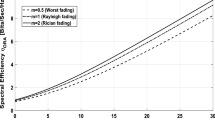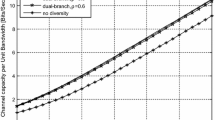Abstract
This correspondence presents the channel capacity analysis of maximal-ratio combining with transmit antenna selection (TAS/MRC) in frequency-flat Nakagami-m fading channel with variable power and rate allocation techniques. In this paper, we evaluated exact closed-form expressions of channel capacity for TAS/MRC under different adaptive transmission techniques (1) optimal simultaneous power and rate allocation (opra) (2) optimal rate allocation with constant transmit power (ora) (3) channel inversion with fixed rate (cifr) and (4) truncated version of (cifr). An exact closed-form expression for channel capacity has been derived in uncorrelated Nakagami-m fading channels with single infinite series of tabulated function while the fading index is a real value. Numerical results illustrate the impact of fading severity on the channel capacity and outline the performance characteristics between the distinctive allocation schemes.




Similar content being viewed by others
References
Telatar, I. E. (1999). Capacity of multi-antenna Gaussian channels. Eur. Trans. Telecommun. Relat. Technol., 10, 585–595.
Foschini, G. J., & Gans, M. J. (1998). On limits of wireless communication in a fading environment when using multiple antennas. Springer Wireless Pers. Commun., 6, 311–355.
Molisch, A. F., Win, M. Z., Choi, Y. S., & Winters, J. H. (2005). Capacity of MIMO systems with antenna selection. IEEE Transactions on Wireless Communications, 4(4), 1759–1762.
Yang, L., & Qin, J. (2006). Performance of the Alamouti scheme with transmit antenna selection for M-ary Signals. IEEE Transactions on Wireless Communications, 5(12), 3365–3369.
Chen, Z., Chi, Z., Li, Y., & Vucetic, B. (2009). Error performance of maximal-ratio combining with transmit antenna selection in flat Nakagami-m fading channels. IEEE Transactions on Wireless Communications, 8(1), 424–431.
Romero-Jerez, J. M., & Goldsmith, A. J. (2009). Performance of multichannel reception with transmit antenna selection in arbitrarily distributed Nakagami fading channels. IEEE Transactions on Wireless Communications, 8(4), 2006–2013.
Tan, B. S., Li, K. H., & Teh, K. C. (2012). Performance study of transmit antenna selection with switch-and-examine combining over Rayleigh fading. IEEE Trans. Veh. Tech., 61(9), 4205–4211.
Alouini, M. S., & Goldsmith, A. J. (1999). Capacity of Rayleigh fading channels under different adaptive transmission and diversity-combining techniques. IEEE Transactions on Vehicular Technology, 48(4), 1165–1181.
Maaref, A., & Aïssa, S. (2005). Capacity of space time block codes in MIMO Rayleigh fading with adaptive transmission and estimation errors. IEEE Transactions on Wireless Communications, 4(5), 2568–2578.
Pan, G., Ekici, E., & Feng, Q. (2012). Capacity analysis of log-normal channels under various adaptive transmission schemes. IEEE Communications Letters, 16(3), 346–348.
Zhang, Y., & Tepedelenioglu, C. (2012). Asymptotic capacity analysis for adaptive transmission schemes under general fading distributions. IEEE Transactions on Information Theory, 58(2), 897–908.
Chauhan, S. S., & Kumar, S. (2014). Capacity analysis of adaptive transmission with space-time block codes in spatially correlated MIMO Nakagami-m fading channels. Springer Wireless Pers. Commun., 79(2), 1211–1222.
Chauhan, S. S. & Kumar, S. (2015). Capacity of orthogonal space-time block codes in spatially correlated MIMO Weibull fading channel under various adaptive transmission techniques. Accepted in Springer. Tele. Syst.
Gradshteyn, I. S., & Ryzhik, I. M. (2000). Table of Integrals, Series, and Products (6th ed.). San Diego: Academic.
Simon, M. K., & Alouini, M. S. (2000). Digital Communication over Fading Channels: A Unified Approach to Performance Analysis. New York: Wiley.
Author information
Authors and Affiliations
Corresponding author
Rights and permissions
About this article
Cite this article
Chauhan, S.S., Kumar, S. Adaptive-Transmission Channel Capacity of Maximal-Ratio Combining with Antenna Selection in Nakagami-m Fading channels. Wireless Pers Commun 85, 2233–2243 (2015). https://doi.org/10.1007/s11277-015-2901-5
Published:
Issue Date:
DOI: https://doi.org/10.1007/s11277-015-2901-5




